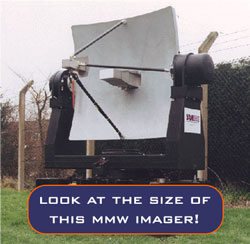
home | Who are we? | Workshop | Resources | Links | Gallery |
| The Basics of Imaging |
A millimetre wave ‘camera’ is bigger than a normal camera. Since the wavelength is typically 6000 times larger than the light your eyes see, the imager needs to focus the light with a much larger lens or mirror. Millimetre wave cameras typically only have a few detecting elements which are very expensive. these must be scanned back and forth across the scene to build up a full picture. This is difficult to do quickly - imagine that your digital camera could only record one pixel at a time: how long would it take you to take a photo? In order to record millimetre wave video less time can be spent looking at each pixel in the image and the temperature reading is less accurate. This is why the video images don’t look as ‘clean’ as the still images. 
TYPES OF IMAGING INFRARED: MILLIMETRE WAVE: PASSIVE IMAGING: ACTIVE IMAGING:
|
'Vision For The Future' is an EPSRC funded project run by the MMW group at the University of St Andrews
Copyright ©2006 by the University of St Andrews :: web, graphic and exhibition design by FifeX Ltd, www.fifex.co.uk